There’s no better feeling than escaping the pitfalls of modern living and getting reacquainted with nature in your RV. But as much as we love a digital detox among jaw-dropping natural scenery, there will come a time when we start to miss the comforts of home.
While an RV’s in-built 12V electrical system is capable of running a whole bunch of gadgets and gizmos—your lights, fan, water pump, and fridge, to name a few—it won’t run any 120V appliances. And that means you’ll have to forgo your favorite coffee machine, TV, blender, console, and laptop computer, etc.—unless, of course, you invest in an inverter for your RV.
Read on to learn all about the technology and discover the ten best RV inverters on the market.
- Features to Consider in an RV Inverter
- Top 10 Best RV Inverters to Buy in 2025
- 1. Best RV Inverter Overall: Krieger 1500 Watts Power Inverter
- 2. Energizer 1500 Watts Power Inverter
- 3. Best Premium RV Inverter: Renogy 3000W 12V Pure Sine Wave Inverter
- 4. Best Budget RV Inverter: Ampeak 1000W Power Inverter
- 5. Best Low Wattage Inverter: BESTEK 300W Pure Sine Wave Power Inverter
- 6. Best High Wattage Inverter: WZRELB 8000W Pure Sine Wave Power Inverter
- 7. WZRELB 3000W Pure Sine Wave Inverter
- 8. Voltworks 2000W Modified Sine Wave Inverter
- 9. POTEK 2000W Power Inverter
- 10. soyond 3000W Power Inverter
- RV Inverter Buyer’s Guide
- RV Inverters: FAQ
- What Does an RV Inverter Do?
- What’s the Difference Between an RV Inverter and Converter?
- How Do I Use an RV Power Inverter?
- What Size Inverter Do I Need for My RV?
- What Size Inverter Do I Need to Run My TV?
- What Can a 1000w Inverter Run?
- What Can a 3000w Inverter Run?
- What Can a 5000W+ Inverter Run?
- Do I Need a Pure Sine Wave Inverter?
- Do I Need an Inverter for My Laptop?
- Do I Need an Inverter to Charge My Phone?
- Best RV Inverters: Final Thoughts
Features to Consider in an RV Inverter
Before we present our top 10 list of the best RV inverters, you should understand what you’re looking at. Here’s what you need to look out for when shopping for an inverter to use in your RV.
Wattage
RV inverters are rated to a certain number of watts, which refers to the maximum power consumption of the appliance(s) they will support. Look for an inverter with a higher wattage than the most energy-hungry device you plan to use.
Surge Wattage
RV inverters are rated to withstand a certain level of surge power, which is when an appliance uses more power than usual for a brief moment. Ensure the surge rating on your inverter is higher than the potential surge spike on your biggest appliance.
Type
RV inverters come in various types: Modified Sine Wave, Pure Sine Wave, and Square Sine Wave (mostly obsolete). Although cheaper, Modified Sine Wave inverters are less efficient than Pure Sine Wave inverters and aren’t suitable for sophisticated electrical devices like computers.
Protections
The last thing you want to do is short circuit your expensive inverter because you tried to dry your hair at the same time the kids were watching TV. High-quality inverters come with a range of inbuilt protective measures to ensure they don’t melt or explode.
Size
Space is of utmost importance in any RV; there’s no point purchasing a bigger power inverter than you have to. If you’re pressed for room, or if you’re planning on moving your inverter between RVs, then a miniature portable inverter might be your best bet.
Price
Our recommended RV inverters range from $50 to $1,500, so the cost will be a crucial factor in your decision. To save money, only buy an inverter that is as powerful as you need it to be.
With these things in mind, let’s find the inverter you need to power up your RV for the road ahead.
| Product | Wattage | Surge Wattage | Inverter Type | Size | Outputs | Rating |
|---|---|---|---|---|---|---|
| Krieger 1500 Watts Power Inverter | 1500W | 3000W | Modified Sine Wave | 13.75 x 7.62 x 3.37 inches | 2x AC plus 2x USB | 5 |
| Energizer 1500 Watts Power Inverter | 1,500W | 3,000W | Modified Sine Wine | 13.75 x 7.6 x 3.5 inches | 2x USB and 2x AC | 5 |
| Renogy 3000W 12V Pure Sine Wave Inverter | 3,000W | 6000W | Pure Sine Wave | 17.5 x 8.7x 3.7 In | 1x USB and 3x AC | 5 |
| Ampeak 1000W Power Inverter | 1,000W | 2,000W | Modified Sine Wave | 8.19 x 5.91 x 2.76 inches | 2x USB and 2x AC | 4.5 |
| BESTEK 300W Pure Sine Wave Power Inverter | 300W | 700W | Pure Sine Wave | 4.92 x 3.39 x 1.93 inch | 2x USB and 2x AC | 4.5 |
| WZRELB 8000W Pure Sine Wave Power Inverter | 8,000W | 16,000W | Pure Sine Wave | 23.4 x 11 x 6.2 inches | 4x AC | 4.5 |
| WZRELB 3000W Pure Sine Wave Inverter | 3,000W | 6,000W | Pure Sine Wave | 14.17 x 8.07 x 3.54 inches | 2x AC | 4.5 |
| Voltworks 2000W Modified Sine Wave Inverter | 2,000W | 4,000W | Modified Sine Wave | 15.24 x 7.87 x 6.57 inches | 2x USB, 3x AC | 4 |
| POTEK 2000W Power Inverter | 2,000W | 4,000W | Modified Sine Wave | 16.14 x 7.09 x 12.8 inches | 1x USB , 3x AC | 4 |
| soyond 3000W Power Inverter | 1,500W | 3,000W | Modified Sine Wine | 13.75 x 7.6 x 3.5 inches | 2x USB and 2x AC | 3.5 |
Top 10 Best RV Inverters to Buy in 2025
1. Best RV Inverter Overall: Krieger 1500 Watts Power Inverter
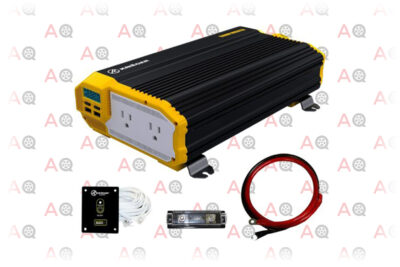
Editor’s Rating:
Quick Facts:
- Wattage: 1500W
- Surge Wattage: 3000W
- Inverter Type: Modified Sine Wave
- Size: 13.75 x 7.62 x 3.37 inches
- Outputs: 2x AC plus 2x USB
This widely popular RV power inverter from KRIËGER is ideal for the average user. Boasting a respectable output of 1,500W (3,000W at peak), the unit is capable of complying with most RVer’s electricity requirements and comes in at a very reasonable price point.
KRIËGER has a rep for creating quality gear that’s built to last, and this particular model comes with a range of built-in protections: Over voltage, under voltage, overload, short circuit, and high temperature. The included LCD will warn the user of potential issues, and the unit comes with a lengthy three-year warranty.
We also love how small this package is—just 13 inches long for a 1,500W inverter is a rarity in this day and age. Its super silent fan is inaudible above your other RV fans, and the unit comes with four outputs (2xUSB and 2xAC) for charging multiple devices.
If you like the look of this product but don’t quite need 1,500W, the good news is it comes in several cheaper, low wattage models as well (plus a few bigger ones, too). Just be aware that it uses Modified Sine Wave technology; thus, it won’t safely charge complex electrical devices.
Pros
- High-performance inverter
- Multiple inbuilt protections
- Handy LCD display
- Good value for money
- Small and compact
Cons
- Modified Sine Wave isn’t suitable for computers
2. Energizer 1500 Watts Power Inverter
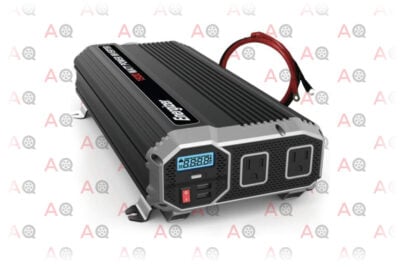
Editor’s Rating:
Quick Facts:
- Wattage: 1,500W
- Surge Wattage: 3,000W
- Inverter Type: Modified Sine Wine
- Size: 13.75 x 7.6 x 3.5 inches
- Outputs: 2x USB and 2x AC
As one of the biggest battery brands in the world, Energizer is a name you can trust. And this high-performance 1,500W inverter does the company proud thanks to its durable design.
The Energizer converter is a viable alternative to the aforementioned 1500W KRIËGER inverter — it offers roughly the same features and performance for approximately the same price. It has a myriad of protective measures like overload, over/under voltage, short circuit, and high-temperature cut-off, rendering it safe under any conditions.
Much like the KRIËGER, you’ll also get a handy LCD to view the current input and output wattages as well as learn of any potential issues. It’s also approximately the same size, has the same number of ports, and boasts a similar silent fan—there’s not much difference between the two.
Between this and the KRIËGER, it’s a close call, but the KRIËGER has a longer three-year warranty (versus the Energizer’s two years), which gives us more confidence in its longevity. Nonetheless, they’re both excellent inverters, so you won’t go wrong with either option.
Once again, it’s a Modified Sine Wave model; thus, efficiency isn’t optimal, and it won’t safely run complex devices.
Pros
- Good value for money
- Trusted well-known brand
- Small and compact
- Multiple protective features
- Long-lasting design
Cons
- Two-year warranty is less than KRIËGER
- Uses inferior Modified Sine Wave technology

Editor’s Rating:
Quick Facts:
- Wattage: 3,000W
- Surge Wattage: 6000W
- Inverter Type: Pure Sine Wave
- Size: 17.5 x 8.7x 3.7 In
- Outputs: 1x USB and 3x AC
The Renogy Group has been making (sine) waves in the American RV space in recent years for its high-quality 12V products that outperform the competition. And this outstanding power inverter is no exception, with a clear and smooth electrical distribution thanks to its use of premium Pure Sine Wave technology.
This particular inverter boasts a conversion efficiency of over 90%, which reduces strain on your battery system and allows you to run your favorite devices for longer than ever before. Minimal harmonic distortion (<3%) further enhances the electrical load, and the inverter will support virtually any domestic appliance—even complex computers and consoles.
Renogy builds its products to last and includes an easy-to-understand LED screen to communicate potential voltage issues. Unlike other products, this inverter will sound an audible alarm to alert the user of overload, under/over voltage, excessive temperature, and more. Don’t worry, though, as it’s unlikely you’ll ever hear the alarm because Renogy has enough inbuilt protections in place to negate the need for human intervention.
This model comes with 3 AC ports to power a range of devices and a remote control for easy access. Note that this is a hardwired unit, so you’ll need a professional to install it unless you’re confident enough to DIY.
Although we’ve recommended the premium 3000W option here, Renogy sells 2,000W, 1,000W, and 700W variations as well.
Pros
- Outstanding performance
- Premium Pure Sine Wave technology
- More efficient than other inverters
- Capable of running virtually any appliance
- Multiple variations available
Cons
- More expensive than other options
- Requires professional installation
4. Best Budget RV Inverter: Ampeak 1000W Power Inverter
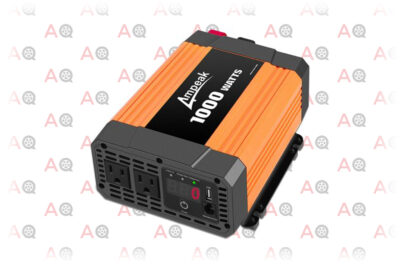
Editor’s Rating:
Quick Facts:
- Wattage: 1,000W
- Surge Wattage: 2,000W
- Inverter Type: Modified Sine Wave
- Size: 8.19 x 5.91 x 2.76 inches
- Outputs: 2x USB and 2x AC
Why pay hundreds of dollars for a fancy RV inverter with all the bells and whistles when this modest model from Ampeak will get the job done with a fistful of change from a Benjamin?
Coming in at well under the hundred dollar mark, this high-performance Modified Sine Wave 1,000W inverter will meet most RVer’s power needs without breaking the bank. It peaks out at 2,000W for those unpredictable surge spikes, and the standard 1,000W load is enough to run or charge most common appliances—think cameras, TVs, tools, laptops, phones, and fancy lights.
A basic digital display gives you information on the input and output wattage, although it fails to warn the user of any potential issues. There is, however, an audible alarm that will let you know if something has gone awry. Furthermore, Ampeak includes an over/under voltage, overload, short circuit, and heat protection function into the device, so you can rest assured this one isn’t going to break any time soon.
The 18-month warranty is a little less than the more expensive inverters on our list, although the company is known for providing quality 24/7 customer support.
If you’re hooked on the value aspect of Ampeak but don’t want a 1,000W product, the company markets multiple other options as well.
Pros
- Excellent value for money
- 1,000W runs most appliances
- Audible alarm
- Multiple automated protections
- Good customer support
Cons
- Modified Sine Wave is less efficient
- Warranty is shorter than most
5. Best Low Wattage Inverter: BESTEK 300W Pure Sine Wave Power Inverter
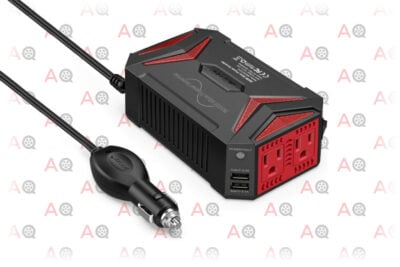
Editor’s Rating:
Quick Facts:
- Wattage: 300W
- Surge Wattage: 700W
- Inverter Type: Pure Sine Wave
- Size: 4.92 x 3.39 x 1.93 inch
- Outputs: 2x USB and 2x AC
If you want the efficiency and compatibility of a premium Pure Sine Wave inverter but don’t need much in the way of watts, this nifty little unit from BESTEK is the best you’ll get.
Coming in at a tiny 5 inches long, the pint-sized inverter easily stashes away in a cupboard or drawer. Whip it out whenever you need and enjoy smooth Pure Sine Wave energy to power your goodies on the go. In addition to its petite stature, this unit is remarkably quiet, so you needn’t worry about that annoying whirring sound.
The product is perfect for users who want to run computers, tablets, and game consoles; Modified Sine Wave inverters would risk frying these delicate systems. Another critical advantage is efficiency, as you’ll experience very little conversion loss with this high-tech device.
Although it comes with two USB and two AC ports, remember that it’s only 300W, so you don’t want to try and run too many things simultaneously. Don’t worry if you do, though, because the system’s automated overload protection will switch it off without harm.
Although it’s not the cheapest low wattage inverter on the market, it performs well and comes with an 18-month warranty.
Pros
- Pure Sine Wave for optimal efficiency and compatibility
- Multiple outlet ports
- Smooth power distribution
- Perfect for complex yet low-wattage electronics
- Multiple automated protections
Cons
- More expensive than other 300W inverters
- Won’t run power-hungry devices
6. Best High Wattage Inverter: WZRELB 8000W Pure Sine Wave Power Inverter
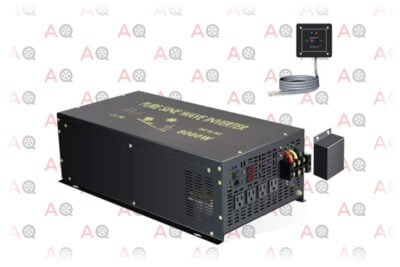
Editor’s Rating:
Quick Facts:
- Wattage: 8,000W
- Surge Wattage: 16,000W
- Inverter Type: Pure Sine Wave
- Size: 23.4 x 11 x 6.2 inches
- Outputs: 4x AC
If you want to run the air-conditioner, fridge, and induction cooktop simultaneously, then you’re going to need a pretty big inverter to handle the electrical load. And this chunky behemoth from WZRELB is about as big as inverters get.
Boasting an impressive 8,000W of continuous power and up to 16,000W on surge, it’s got enough juice to run all your essential electrical appliances at the same time. The unit is a hit with full-time trailer dwellers who’d rather not plug into the mains, although it works just as well for mobile RVers too. Be aware this thing is enormous, almost two feet in length, and weighing a whopping 40 pounds.
You’ll be paying well over a thousand dollars for a unit that only comes with a one-year warranty, so there is an element of risk involved. Nonetheless, if you need up to 8000W of power, there’s not much else out there that caters to you.
The high-frequency device uses Pure Sine Wave technology at 60HZ to deliver smooth continuous power, making it perfect for off-grid homes and worksites as well as an RV. The four AC outlets operate at the usual 15Amps, and the device comes with a remote control plus an LED display for easy use.
As you’d expect from such a bulky inverter, all the standard protections—over/undercharge, low voltage, high temperature, and short circuit—come included in the deal.
Pros
- Highest wattage on the market
- Runs multiple appliances at once
- Pure Sine Wave technology
- Easy to use LED display
- All the essential protections
Cons
- Expensive
- Short one-year warranty
7. WZRELB 3000W Pure Sine Wave Inverter
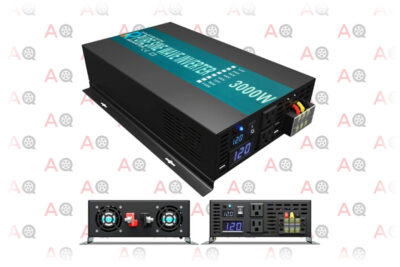
Editor’s Rating:
Quick Facts:
- Wattage: 3,000W
- Surge Wattage: 6,000W
- Inverter Type: Pure Sine Wave
- Size: 14.17 x 8.07 x 3.54 inches
- Outputs: 2x AC
Although the little-known brand WZRELB has a strange name, there’s nothing unusual about the performance of their signature 3,000W inverter.
The powerful machine provides RV users with all the wattage they need, easily enough to run multiple smaller appliances simultaneously. This product supports peak loads as high as 6,000W, too, so you don’t need to stress about those all-too-frequent energy spikes. A lot of this high-wattage capability stems from the extra thick 2mm PCB that’s specially designed to strengthen load capacity.
A user-friendly LED display lets you know the input and output wattage, as well as any essential alerts. There’s no audible alarm here, however, so you’ll need to keep an eye on the screen.
As we’re talking about a Pure Sine Wave inverter here, you can expect a smooth electrical distribution and minimal efficiency loss. True copper inductance and top quality MOSFETs work in conjunction to achieve optimal output performance.
Pros
- Pure Sine Wave Inverter
- Thick 2mm PCB
- Excellent quality MOSFETs
- Various options available
- LED display
Cons
- No audio alarm for alerts
- Little-known brand
8. Voltworks 2000W Modified Sine Wave Inverter
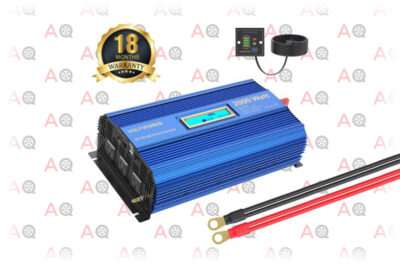
Editor’s Rating:
Quick Facts:
- Wattage: 2,000W
- Surge Wattage: 4,000W
- Inverter Type: Modified Sine Wave
- Size: 15.24 x 7.87 x 6.57 inches
- Outputs: 2x USB, 3x AC
Voltworks make a 2,000W 12-volt inverter that – well – works. This nifty little DC to AC device offers continuous power up to 2,000w across multiple devices and can support surge peaks as high as 4,000W.
Expect to find three AC ports and two fast-charging USBs, which should be plenty to power the necessary appliances in your RV. Don’t go overboard, though, because 2,000W isn’t unlimited, so you’ll need to calculate your usage before making a purchase.
One thing we love about this design is how user-friendly it is. Coming with a simple-to-understand LCD display and an intuitive remote control, even the first-time inverter user won’t have trouble figuring this one out. All the essential info—alerts, output, and input—is readily available, and you can change settings at the switch of a button.
The device comes with all the usual protections and is built tough in a durable aluminum shell—perfect for life on the road. The cooling fan is pretty quiet, too, which you’ll notice most when you’re trying to sleep. The device comes with an 18-month warranty, slightly shorter than most of the competition.
Pros
- Pure Sine Wave technology
- Powerful 2,000W inverter
- Quiet fan
- Durable metallic casing
- Easy to use
Cons
- Slightly shorter warranty than others
9. POTEK 2000W Power Inverter
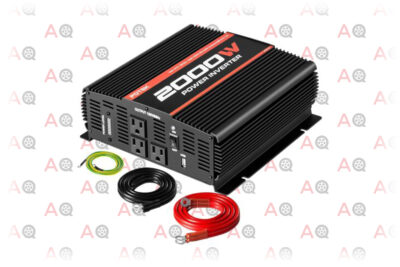
Editor’s Rating:
Quick Facts:
- Wattage: 2,000W
- Surge Wattage: 4,000W
- Inverter Type: Modified Sine Wave
- Size: 16.14 x 7.09 x 12.8 inches
- Outputs: 1x USB , 3x AC
For users who don’t need the efficiency and compatibility of Pure Sine Wave, this respectable Modified Sine Wave inverter from POTEK is a viable option at the 2,000W mark.
The unit is somewhat similar to the Voltworks 2,000W Inverter — you get the same wattage, outlets, and protections. It does cost about 10% less, however, which is a significant selling point for RVers who need to count their pennies.
One thing we don’t like about this mode is that it only comes with a single USB port. Considering our most essential devices—think cellphones, tablets, eBooks, etc.—all come in USB these days, it might have been nice to include one more.
Another downside is the fuses, which are prone to breakage from time to time, are located in a hard to reach spot inside the inverter. It’s still possible to do a DIY fix; just a bit more time and effort is involved.
The inverter comes with 3 AC outlets and enough juice to run multiple low-wattage devices simultaneously.
Pros
- Powerful 2,000W inverters
- Comes with multiple automated protections
- Has three AC outlets
- Cost-effective inverter
Cons
- Fuses are hard to reach
- Only has one USB port
10. soyond 3000W Power Inverter

Editor’s Rating:
Quick Facts:
- Wattage: 1,500W
- Surge Wattage: 3,000W
- Inverter Type: Modified Sine Wine
- Size: 13.75 x 7.6 x 3.5 inches
- Outputs: 2x USB and 2x AC
Need 3,000W of power but don’t have the cash to splash on a fancy high-end model? Then this budget Modified Sine Wave offering from soyond is the ideal solution. With it, you’ll enjoy 3,000W of continuous power and up to 6,000W of peak power but at a relatively low price point.
Although the unit isn’t specifically designed for RV use, it does the job just right in a mobile home. What’s more, a wide range of automated protections—over/under voltage, overload, overheat, and short circuit—helps it stand the test of time.
On the downside, this unit is fresh off the boat from China, so the translation on the instruction manual can be a little hard to read. Don’t expect much in terms of customer service, either—you get what you pay for, as the old saying goes.
We also don’t like the fact there’s no LED display, making it impossible to determine what the input and output wattage is running at.
Pros
- Affordable 3,000W inverter
- Multiple automated protections
- Suitable for RV and home use
Cons
- No LED display
- Instructions are confusing
- Customer service is poor
RV Inverter Buyer’s Guide
The inner-workings of an RV electrical system are challenging to understand, especially for the layman who’s new to the concept of mobile living. So to help unravel the mystery, we’ve put together this in-depth buyer’s guide on the RV inverter, which includes a bit of handy background knowledge on how an RV’s electrics work.
The Electrical Systems of an RV
Most RVs run off two parallel electrical systems: 120V and 12V.
The 12V System
The 12V system uses direct current (DC) to run the core appliances of your RV—all the low wattage items that need to be constantly running, or at least constantly accessible. Although the 12V devices found on an RV vary, expect to see the refrigerator, lights, fans, and water pump on there.
The 12V system is powered by a “house” battery, usually either lead acid or lithium. This battery is charged as you drive via an alternator or from the sun via solar panels.
A limited number of household appliances are available in 12V versions—televisions, vacuum cleaners, and kettles—which come with a car cigarette lighter input rather than a standard household plug. For the most part, though, household appliances generally run off the 120V system.
The 120V System
The 120V system of an RV uses alternating current (AC) to run all the more powerful appliances once the vehicle has been connected to “shore power” (the electricity grid).
Appliances such as microwaves, kettles, electric stoves, and air conditioners use more power than most RV battery systems can handle. For this reason, many RVs are wired in a way you can connect these appliances directly to the mains electricity grid (either at an RV park or a private home) and use them at will.
And that’s why most RVers can run their air conditioner at the RV park but not while boondocking down by the river.

What Is an RV Inverter?
An RV inverter converts 12V DC electricity from your house battery into 120V AC electricity to power your everyday home appliances. As a result, you’ll get to run all your favorite 120V appliances off your leisure battery rather than having to rely on the shore power at an RV park.
Of course, there’s a big caveat to the concept: you need to have a powerful 12V battery and solar system to run big 120V appliances through an inverter.
What Can an Inverter Run?
An expensive, high-quality inverter—say, an 8,000W Pure Sine Wave inverter—can run just about anything imaginable, from a small bedside lamp to an oversized air-conditioner. Less powerful and cheaper inverters—like a portable 300W inverter, for example—might only just manage to run your coffee grinder.
Therefore, the amount you pay affects what your inverter will run. So if you only really want to run a coffee grinder, there’s no point getting anything more powerful than the aforementioned portable option.
Why Should I Get an RV Inverter?
An RV inverter gives you the freedom of being able to use all your favorite electric appliances anywhere you choose—no more plugging into the RV park shore power each day just to watch TV.
Without an RV inverter, you wouldn’t be able to use any 120V appliances or electronics, which typically consist of televisions, coffee machines, blenders, and laptop chargers, among other things.
Because an RV inverter lets you use all your essential appliances while boondocking, it means you’ll have the chance to live off the grid and save big bucks on RV park fees.
RV Inverter Protections
Low-quality inverters have a nasty habit of malfunctioning—and sometimes even self-destructing—when exposed to a heavy electrical load. A good quality inverter will have several inbuilt protections to prevent it from malfunction or potential damage.
Protections vary on the inverter in question, although standard features include under voltage, over voltage, overload, short circuit, and high-temperature protection.
RV Inverter Types
There are three types of RV inverters on the market, which we’ll outline below.
Square Wave
These old-school inverters have largely been outdated by more powerful and efficient types, but you can still see a few floating around from time to time. Square Wave inverters can only run low power appliances that don’t have any complex circuitry or systems.
Modified Sine Wave
Modified Sine Wave inverters have become increasingly popular in recent years because they offer great bang for your buck. These inverter types cost a fraction of the more expensive Pure Sine Wave variety yet still run most electrical appliances with ease.
Do note, however, that Modified Sine Wave inverters can damage complex electronics such as laptops and Smart TVs. These cheaper inverters are also less efficient, so they’ll chew through your battery at a faster rate.
Pure Sine Wave
The crème de la crème of the inverter world, these high-tech machines will run any device under the sun—as long as it’s 120V AC. Pure Sine Wave inverters won’t damage even the most complex computer systems and are notably more efficient than the Modified Sine Wave variety.
The downside is they’re also relatively expensive, and the additional outlay may not be worth it for you.
Inverter Wattage: How Much Do I Need?
All three types of RV inverters are rated to a specific wattage, which refers to the maximum amount of watts the unit can convert.
The key is to purchase an RV inverter with a wattage that exceeds the most demanding device you want to convert.
So, for example, if you need to watch TV off-grid and your screen uses 100W, then you’d only need to purchase an inverter of 100W or higher. Don’t go too much higher, though, or you’d be spending extra money unnecessarily because your inverter would be more powerful than you need it to be.
One crucial thing to consider is whether you need to convert the current for multiple appliances simultaneously. For example, if you want to play Xbox (65W) on your TV (100W), then you’d need an inverter rated to 165W or higher.
RV Inverter Surge Rating
Although electrical appliances are rated to a set wattage, the reality is many will occasionally surge past that amount for a short amount of time.
Therefore, to ensure your gadgets run correctly, your RV inverter must either exceed that amount in its standard wattage rating or have a sufficient surge wattage rating. The surge wattage on an RV inverter refers to what it can run for a short period.
Installing an RV Inverter
The installation process for an inverter varies. Some require hardwiring while others are simply plugged into the 12V battery.
You’ll manage to save a significant sum of cash if you install your RV inverter yourself because auto electricians don’t come cheap. The process isn’t easy, though, so thoroughly research the installation process of your preferred inverter and gauge whether doing it DIY is realistic for you.
Some low-end inverters, on the other hand, don’t require any installation because all you do is plug it into the 12V socket and use it like you would an adapter.
You’ll also need to consider the size of the inverter. If you haven’t got much space to spare, then you might be forced to buy a smaller inverter than you’d initially hoped for (smaller inverters are generally less powerful).

RV Inverters: FAQ
Still got a few questions about RV inverters? Take a look at our FAQ below.
What Does an RV Inverter Do?
An RV inverter converts 12V DC electricity from your house battery into 120V AC electricity, which is compatible with everyday household appliances. In effect, an inverter lets you run all the electrics you’re used to using at home, assuming your battery is powerful enough.
What’s the Difference Between an RV Inverter and Converter?
While an RV inverter converts DC to AC, a converter does the opposite, converting AC into DC. That way, your 12V appliances will run directly off the 120V mains power and won’t drain your battery while you’re plugged into the grid.
How Do I Use an RV Power Inverter?
Assuming your inverter has been properly installed, all you need to do is plug your gear in and turn it on. An inverter will automatically convert DC to AC electricity so you can use your 120V appliances straight away without having to twiddle any knobs.
What Size Inverter Do I Need for My RV?
The ideal wattage depends entirely on what you plan to run, so there’s no universal answer to this question. Remember, you’ll pay more for a higher wattage inverter; therefore, it makes financial sense to purchase the lowest possible wattage that will still run your appliances.
You need to factor in surge wattage, however, as many appliances will occasionally spike over the listed wattage amount. The tricky part is many appliance manufacturers don’t disclose the surge wattages, which can be unpredictable at times.
You also need to factor in whether you’ll run multiple appliances simultaneously and add those up to get your desired maximum wattage.
What Size Inverter Do I Need to Run My TV?
Modern TVs don’t use much power, with the smaller varieties coming in at well under 100 watts. Even if you want something massive (which you might struggle to fit in your RV anyway), you’re unlikely to go above 300W or so.
If you’re planning on buying an inverter purely to power a TV, consider opting for a 12V TV instead. Then no inverter needed as it already runs off of 12 volts. If you’re looking for an antenna for your RV, we have an entire article about the best ones available for you to read.
What Can a 1000w Inverter Run?
With a 1000W inverter, you’ll be able to run a whole host of household appliances, including laptops, most coffee machines, TVs, stereos, vacuum cleaners, and so on.
What Can a 3000w Inverter Run?
A 3000W inverter will run all of the above plus power-hungry electric cookers such as this Mini Duo cooktop from True Induction.
What Can a 5000W+ Inverter Run?
Inverters rated at 5000W or more are capable of running just about any appliance you could need in an RV and will support multiple power guzzling devices at the same time.
Some people buy these turbocharged inverters to power an RV air-conditioning unit while they’re boondocking off the grid, an enviable setup that’s the ultimate in luxury RV living. But before you get too excited and purchase a sweet new Dometic AC, be aware you’ll need a massive battery and solar system to support it—think 500AH of lithium and 800W of solar.
Do I Need a Pure Sine Wave Inverter?
For basic appliances like microwaves, kettles, TVs, and sound systems, the cheaper Modified Sine Wave inverter will work just fine. If you plan on running complex electronics such as computers and game consoles, then a pure sine wave is essential as Modified Sine Wave inverters could fry the electrics.
Also, note that Pure Sine Wave inverters are more efficient; thus, you’ll draw less power from your batteries and ultimately be able to run your appliances for longer.
Do I Need an Inverter for My Laptop?
Although many RVers run their laptop computers off an inverter, you’re better off using an adaptor. Laptops already run on about 18V, so converting one into 120V then back again to 18V will be less efficient and create unnecessary strain on your battery.
A DC laptop charger costs much less than an inverter and will charge your laptop more efficiently. Just be aware it won’t charge any other appliances, and you’ll need to ensure it’s compatible with your particular laptop (check the size of the charging pin).
Do I Need an Inverter to Charge My Phone?
Your cell phone and anything else you can charge on USB doesn’t require an inverter either. Simply plug a 12V USB adapter into your RV’s DC outlet and connect the appropriate charging cable.
Best RV Inverters: Final Thoughts
Investing in an RV inverter will allow you to use all your everyday electronic appliances on the road, even when you’re not plugged into an RV park. And that gives you the freedom to boondock for days on end in a stunning remote locale while still savoring the benefits of modern living.
However, before making a purchase, you must obtain a strong understanding of what inverters are and how they work. Otherwise, you could end up buying a product that’s too powerful or too meek for your needs; nobody likes throwing money away.
Now that you’ve finished reading our in-depth buyer’s guide, you’ve got all the info you need to purchase an inverter for your own RV. All that’s left to do now is browse through our Top 10 RV Inverters list to pick out the product that best caters to your needs.


